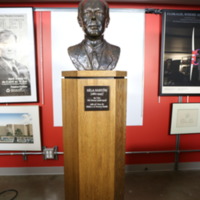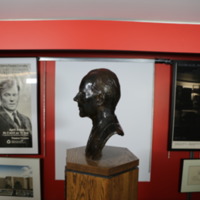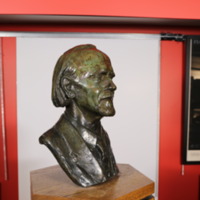Where are the busts now?
Now that we have discussed the historical context surrounding the controversy of the busts, it is time to revisit the busts themselves. After the National Arts Centre was sent the note expressing concern about the display of these busts in their facility, members of the NAC staff conducted research on acceptance of the donation of the busts and what to do with future donations that may have controversial pasts. They discussed the importance of still acknowledging state-funded artwork as an important source of cultural history, as well as keeping the political associations of the artist and composers at arms-distance (Various authors 1997). There were also discussions about creating a board to discuss future donations associated with political histories to ensure they wouldn’t offend or trigger members of the public with artwork they chose to display (Various authors 1997). These discussions, however, came to a halt when the busts were moved to storage while the hall they were displayed in was renovated (Various authors 1997). They remain in storage to this day, but the question of whether they should be moved back to a display remains.
There were no legal restrictions preventing the acceptance of these donations, as the art itself was not obtained illegally (National Gallery of Canada Collections Procedures 1992, 3). Therefore, how these busts should be displayed in a respectful manner is concerned more with presenting art from another culture in a manner that is that disrespectful to that culture’s history. Although there is not much research on displaying Hungarian works in a respectful manner, many of the concepts around displaying otherwise controversial art and art from oppressed cultures in a respectful manner are applicable (Younker 2017; Manchin 2017; Mancuso 2018; Campfens 2019). If these busts are to be displayed once again, it could be in an exhibit or gallery setting rather than simply being placed out in a main foyer of the building.
As these busts are not a form of religious or ceremonial art nor are they stolen, there are no concerns about displaying them in a context that would be offensive, apart from ensuring that the historical context of the artwork is addressed in a respectful manner. The exhibit could address the trauma faced by Hungarians living under the Communist regime, and the fact that many of the individuals in powerful political positions today are the same individuals who ran the Communist Party (Various authors 1997), despite Hungary now being known as a Socialist country rather than Communist.
Along with addressing the oppression and horrors that Hungarian citizens faced, the exhibit should acknowledge the amount of control the government retained over artists and the artwork they were allowed to produce. This would open space for discussion on the severe punishments artists in Soviet-aligned countries could face for producing artwork that didn’t meet the criteria to be acceptable by the government. The most important part of creating this exhibit, however, should be input from Hungarian-Canadians on what is appropriate and important to include. The team should work closely with the Hungarian-Canadian community to cultivate an exhibit that accurately represents their history while acknowledging the horrors that they escaped by fleeing to Canada in a manner that is respectful and avoids triggering the community as much as possible.
Whether or not the National Arts Centre is the right place for this exhibit to take place is the only remaining question. I would argue that these busts should be displayed in a museum or gallery setting. The exhibit should have ample space to discuss art in Soviet-aligned Communist countries and perhaps include more artists’ work than just Pàtzay’s. The exhibit should be created in close collaboration with Hungarian-Canadians familiar with the trauma many people in their community faced to ensure that the exhibit is an accurate representation of art and everyday life under the oppressive regime of the Hungarian Communist Party.






